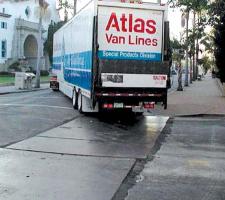
Oregon has a number of vulnerable bridges
David Crawford reviews commercial vehicle route protection strategies.
The growing impact of heavy commercial vehicles on urban and interurban highway infrastructures around the world is driving the need for reliable route access restriction and monitoring. The support role of enforcement is proving fertile ground for ITS development.
Bridges are especially vulnerable – and critical in terms of travel delays. The US state of Oregon’s Department of Transportation (ODOT) operates what it claims is one of the country’s most aggressive truck route restriction enforcement programmes to protect its fragile crossings from damage by oversized/overweight (OS/OW) vehicles.
Once it has identified a need for access control, its user notification process updates the Trucking Online master version of its Road and Bridge Restrictions List, maintained by analysts who use an electronic routing manual to decide safe truck navigation instructions.
Enforcement is effectively through the state’s Green Light network of 22 inspection stations which have both overweight and overheight monitoring. These use Canada-HQ’d69 International Road Dynamics’ iSINC control technology, and transponder-based RFID automated vehicle identification (AVI) with devices from 4984 Kapsch TrafficCom.
Inspection sites are largely located where there are minimal bypass options. The state claims a ‘very high level’ of coverage for the protection of weight- and height-restricted bridges and other sensitive infrastructure, with opportunities for enforcement officers to intercept and redirect potential violators.
An784 ODOT spokesperson told ITS International: “This strategy casts an enforcement shadow across the breadth of Oregon, providing maximum deterrence with available staff.” At the busiest inspection station, the Woodburn port of entry from Washington State, ODOT has introduced pre-sorting using a 1919 Perceptics automated numberplate recognition camera for vehicle identification. Compliant trucks are routed back onto the freeway.
Across 31 US states, HELP (Heavy vehicle Electronic Licence Plate) Inc’s PrePass AVI system for pre-clearing credentialised trucks at inspection stations monitors OS/OW and other state-requested factors, with scope for customised dimensioning to prevent bridge strikes or other out-of-route incidents. The not-for-profit, public-private partnership has now started a pilot designed to allow certain pre-specified vehicles that would otherwise be blocked to operate under PrePass pre-clearance.
Each state will determine the loads or dimensions to authorise.5225 HELP Inc president and CEO Karen Rasmussen told ITS International that she expects some trucks to start operating “within the next 12 to 18 months, as jurisdictions choose.” The system has parallels with Australia’s Intelligent Access Program (see below).
Kapsch TrafficCom, which supplies transponders to PrePass, learnt in January 2015 of its selection as a roadside equipment supplier for the US Department of Transportation ITS Joint Program Office’ connected vehicle (CV) safety pilot. A key element will be 5.9GHz dedicated short range communications technology, as deployed in the company’s V2X commercial vehicle operations and road safety enforcement systems, designed to support government agencies in heavy vehicle traffic regulation.
Steve Sprouffske, ITS solutions manager with Kapsch TrafficCom North America, stresses the role of the company’s connected vehicle solutions in capturing the “whole truck” concept of driver, vehicle and carrier information. “This enables bi-directional communications with roadside infrastructure, sending driver, vehicle and carrier data out for assessment and enforcement and bringing guidance back”.
He cites a recent ‘escreening’ commercial vehicle inspection pilot, supported financially by the New York State Energy Research and Development Authority, as demonstrating effective route communication with the driver. “Why is this important? Ever changing route restrictions for OS/OW trucks and ones carrying hazardous materials (HAZMAT), which create environmental and roadway damage costing the state millions in clean-up and repair costs. Again, off-route penalties for carriers can be crippling in a highly competitive industry.”
USDOT has already worked in parallel with NYSERDA, as part of its CV development programme. In addition to safety benefits, Kapsch TrafficCom calculates from its European experience that its approach can save 8% in roadway maintenance costs and extend pavement lifecycles by between five and seven years.
Says Sprouffskje: “We’ll work with each individual US state to develop the necessary business rules for their individual needs and physical circumstances.”
It warns that, despite the issue of truck route maps, ‘problems will decrease only if operators obey routes and restrictions.’ A 2011 Truck Safety Enforcement Study found that the cost impacts resulting from commercial vehicle traffic on bridges along truck routes run at some US$7 million per year.
The report follows a May 2014 initiative in which DDOT deployed a citywide network of cameras at offender blackspot sites under its automated speed and truck restricted route enforcement programme. The initiative responds to the District’s townscape as a city of neighbourhoods, with residential streets not built to handle the weight, noise and damaging impacts of rat-running commercial vehicles.
The move aims both to reduce maintenance costs and enhance quality of life.
One problem is the lack of information about trucks travelling within the district; making it difficult to come to informed decisions about how to route the vehicles. For example bridge weight restrictions are not immediately available to the haulage industry.
The Freight Plan recommends dynamically routing truck traffic based on real-time traffic conditions. It also advocates working with companies like geologistics developer2274 ALK Technologies which, in collaboration with freight management specialist 8040 Omnitracs, has developed CoPilot Truck.
This GPS-based navigation system takes account of restricted and prohibited roads and enables customisable vehicle dimensioning to guide drivers along legal routes (including those designated for flammable material or hazardous chemical loads).
The Freight Plan also urges DDOT to push for the incorporation of legal truck routes into the offers of commercial GPS navigation system providers. Overall, it recommends moving towards a future of automated enforcement within the context of the US Federal Highway Administration’s emerging Smart Roadside Vision concept for collocating installations to allow for integration and data sharing. The illustration below shows typical current roadside array exemplifying the desired coordination.
In a parallel initiative, the December 2013 draft Chicago Truck Route Planning Study, produced by consultants5673 Cambridge Systematics, set out to link the updating of the city’s designated truck route network to long-term goals including effective enforcement. As with Washington DC and DDOT, neighbourhood factors are an issue.
The study has developed a single geographic information system-based repository for carrying out spatial analysis and determining the eventual network. The final product is intended to be an easily understandable truck route designation and enforcement map for use by both public and private sectors.
The scheme, developed in partnership with the country’s state road authorities, uses satellite tracking and wireless communication to remotely monitor both the operation of equipped vehicles on the nation’s highway network and the extent to which they are complying with pre-agreed routes and access conditions. The TCA’s National Heavy Vehicle Regulator maintains an interactive online journey planner which displays approved routes and enables participating hauliers to identify in advance the locations where they will need entry permits.
A company can then negotiate enhanced network access, which can help it to achieve productivity gains and better turnround times - notably when carrying higher mass limit loads. Violations automatically generate non-compliance reports for enforcement action.
The service provider is Australian logistics system developer8041 Transtech which in June 2014, working in conjunction with the TCA, started the delivery of an operational AIP pilot for Trafikverket, the Swedish Transport Administration – its first deployment outside Australia. Comments 6301 Trafikverket chief strategist Anders Berndtsson: “We see IAP and similar systems as instruments for better risk management. This will help us use our network while reducing climate impacts.”
The growing impact of heavy commercial vehicles on urban and interurban highway infrastructures around the world is driving the need for reliable route access restriction and monitoring. The support role of enforcement is proving fertile ground for ITS development.
Bridges are especially vulnerable – and critical in terms of travel delays. The US state of Oregon’s Department of Transportation (ODOT) operates what it claims is one of the country’s most aggressive truck route restriction enforcement programmes to protect its fragile crossings from damage by oversized/overweight (OS/OW) vehicles.
Once it has identified a need for access control, its user notification process updates the Trucking Online master version of its Road and Bridge Restrictions List, maintained by analysts who use an electronic routing manual to decide safe truck navigation instructions.
Enforcement is effectively through the state’s Green Light network of 22 inspection stations which have both overweight and overheight monitoring. These use Canada-HQ’d
Inspection sites are largely located where there are minimal bypass options. The state claims a ‘very high level’ of coverage for the protection of weight- and height-restricted bridges and other sensitive infrastructure, with opportunities for enforcement officers to intercept and redirect potential violators.
An
Across 31 US states, HELP (Heavy vehicle Electronic Licence Plate) Inc’s PrePass AVI system for pre-clearing credentialised trucks at inspection stations monitors OS/OW and other state-requested factors, with scope for customised dimensioning to prevent bridge strikes or other out-of-route incidents. The not-for-profit, public-private partnership has now started a pilot designed to allow certain pre-specified vehicles that would otherwise be blocked to operate under PrePass pre-clearance.
Each state will determine the loads or dimensions to authorise.
Kapsch TrafficCom, which supplies transponders to PrePass, learnt in January 2015 of its selection as a roadside equipment supplier for the US Department of Transportation ITS Joint Program Office’ connected vehicle (CV) safety pilot. A key element will be 5.9GHz dedicated short range communications technology, as deployed in the company’s V2X commercial vehicle operations and road safety enforcement systems, designed to support government agencies in heavy vehicle traffic regulation.
Steve Sprouffske, ITS solutions manager with Kapsch TrafficCom North America, stresses the role of the company’s connected vehicle solutions in capturing the “whole truck” concept of driver, vehicle and carrier information. “This enables bi-directional communications with roadside infrastructure, sending driver, vehicle and carrier data out for assessment and enforcement and bringing guidance back”.
He cites a recent ‘escreening’ commercial vehicle inspection pilot, supported financially by the New York State Energy Research and Development Authority, as demonstrating effective route communication with the driver. “Why is this important? Ever changing route restrictions for OS/OW trucks and ones carrying hazardous materials (HAZMAT), which create environmental and roadway damage costing the state millions in clean-up and repair costs. Again, off-route penalties for carriers can be crippling in a highly competitive industry.”
USDOT has already worked in parallel with NYSERDA, as part of its CV development programme. In addition to safety benefits, Kapsch TrafficCom calculates from its European experience that its approach can save 8% in roadway maintenance costs and extend pavement lifecycles by between five and seven years.
Says Sprouffskje: “We’ll work with each individual US state to develop the necessary business rules for their individual needs and physical circumstances.”
Urban context
City infrastructure is also vulnerable to heavy vehicles. The October 2014 US District of Columbia Freight Plan, produced for the Washington DC capital region by its Department of Transportation (DDOT) and consultants CDM Smith, projects a likely doubling of freight movements by 2040.It warns that, despite the issue of truck route maps, ‘problems will decrease only if operators obey routes and restrictions.’ A 2011 Truck Safety Enforcement Study found that the cost impacts resulting from commercial vehicle traffic on bridges along truck routes run at some US$7 million per year.
The report follows a May 2014 initiative in which DDOT deployed a citywide network of cameras at offender blackspot sites under its automated speed and truck restricted route enforcement programme. The initiative responds to the District’s townscape as a city of neighbourhoods, with residential streets not built to handle the weight, noise and damaging impacts of rat-running commercial vehicles.
The move aims both to reduce maintenance costs and enhance quality of life.
One problem is the lack of information about trucks travelling within the district; making it difficult to come to informed decisions about how to route the vehicles. For example bridge weight restrictions are not immediately available to the haulage industry.
The Freight Plan recommends dynamically routing truck traffic based on real-time traffic conditions. It also advocates working with companies like geologistics developer
This GPS-based navigation system takes account of restricted and prohibited roads and enables customisable vehicle dimensioning to guide drivers along legal routes (including those designated for flammable material or hazardous chemical loads).
The Freight Plan also urges DDOT to push for the incorporation of legal truck routes into the offers of commercial GPS navigation system providers. Overall, it recommends moving towards a future of automated enforcement within the context of the US Federal Highway Administration’s emerging Smart Roadside Vision concept for collocating installations to allow for integration and data sharing. The illustration below shows typical current roadside array exemplifying the desired coordination.
In a parallel initiative, the December 2013 draft Chicago Truck Route Planning Study, produced by consultants
The study has developed a single geographic information system-based repository for carrying out spatial analysis and determining the eventual network. The final product is intended to be an easily understandable truck route designation and enforcement map for use by both public and private sectors.
At national level
While the US lacks a national scheme, Australia’s country-wide Intelligent Access Program (IAP) is fast gaining momentum with the 29 October 2014 announcement by the Transportation Certification Authority that some 25,000 vehicles have now installed in-vehicle units - a 65% increase on 2012 numbers. Says TCA CEO Chris Koniditsiotis: “This signals that the transport industry is seeking to optimise the management of its heavy vehicles, irrespective of the need to enrol them for road access.”The scheme, developed in partnership with the country’s state road authorities, uses satellite tracking and wireless communication to remotely monitor both the operation of equipped vehicles on the nation’s highway network and the extent to which they are complying with pre-agreed routes and access conditions. The TCA’s National Heavy Vehicle Regulator maintains an interactive online journey planner which displays approved routes and enables participating hauliers to identify in advance the locations where they will need entry permits.
A company can then negotiate enhanced network access, which can help it to achieve productivity gains and better turnround times - notably when carrying higher mass limit loads. Violations automatically generate non-compliance reports for enforcement action.
The service provider is Australian logistics system developer















